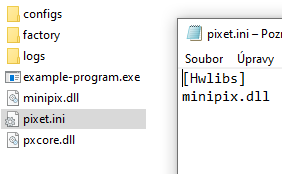Pixet SDK
Pixet SDK
Overview
We provide SDK for our products. Currently it has binary and python API.
Each API contain 3 groups of using type:
Basic measuring and settings
- Settings of the device
- Getting information about the device
- Single frame measurement
- Multi-frame measurement
- Data-driven (pixel mode) measurement
Cluster processing
- Searching for clusters in saved data
- Measuring with online searching for clusters
- Getting informations about clusters - Time of arrival, energy, size, ...
Spectral imaging
- Cluster processing with convert each cluster to pixel and create image
- Getting spectrum information from whole chip or from selected area
Binary (C) APIs
This APIs contains binary libraries, DLLs for Windows and SOs for Linux.
It is intended to be easily used from C/C++, but it is also possible to use it from many other languages, e.g. C#, kotlin, ... and can be imported to the LabView.
This API was created as simplified, for ease of use, for example in industry, so it is not object-oriented, for example.
Binary libraries are available in 32 and 64 bit versions for PCs and for ARMs and can be used on PC, RPi and some Android phones
The binary API has parts:
Core/basic API
With the pxcore library, allowing common measurements and device settings.
See Binary core API
Clustering API
With the pxproc library, designed for searching and processing clusters. Processing is possible online during measurement, or offline by processing data from files.
See Binary Clustering API
Spectral Imaging API
Also with the pxproc library, which, after cluster processing, additionally creates frames, where a single pixel is created from each cluster. And energy spectrum graphs can also be easilly generated. From the entire surface or a selected section.
See Binary Spectral Imaging API
Python API
The Python API was created primarily for scientific purposes, so it is quite extensive and fully object-oriented. It can be used either directly using Python installed on the computer or from a small IDE integrated in the Pixet program.
API files list:
- pypixet.pyd - Basic API file for all basic device functions like as settings, measuring and get status information.
- pypxproc.pyd - Pixel processing, used by Clustering and Spectral imaging objects.
- pypixetgui.pyd - API for using the Pixet GUI. programmer can create windows, dialogs, graphs, ... (Usable only if started from the IDE integrated in the Pixet program)
This API also using the pxcore and pxproc libraries.
See Python API
Auxilliary files
If you want using some our API, you need an auxilliary files:
- The pixet.ini file located in the program starting directory.
- hwlib file(s) listed in the pixet.ini.
- Drivers for some devices properly installed on the computer.
- Additional files required for some devices. Typically FPGA firmwares. Located in the program starting directory.
- Device factory configuration XML file(s) for individual device. Located by pixet.ini settings, default is the "factory" subdirectory of the program starting directory.
- Location for saving the current configuration, with write enabled. Located by pixet.ini settings, default is the "configs" subdirectory of the program starting directory.
- Location for storing log files, with write enabled. Located by pixet.ini settings, default is the "logs" subdirectory of the program starting directory.



